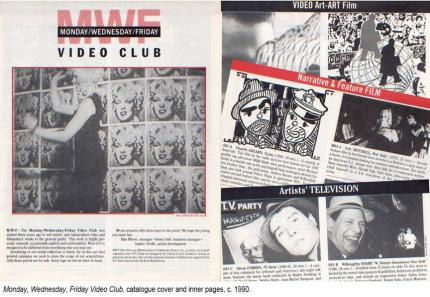 XFR STN (Transfer Station)
XFR STN (Transfer Station)
XFR STN (Transfer Station)
***
My and other Colab artists texts documenting the XFR STN project/show at the New Museum @
http://235bowery.s3.amazonaws.com/exhibitionlinks/91/XFRSTN_Artists'Texts_pdf.pdf
**
XFR STN opened at the New Museum with a General Assembly Thursday, July 18, 2013
**
Downtown New York film and video from the 1970s, 80s and 90s in technical crisis as seen through the lens of The MWF Video Club (1986-2000), a distribution project by Alan W. Moore and Collaborative Project Inc. (Colab). http://www.newmuseum.org/exhibitions/view/xfr-stn
***
I have an early video in it called “When Things Get Rough on Easy Street.”
*********
My XFR STN text:
*********
Static vibrating video was the perverse idea for my “When Things Get Rough on Easy Street” video. I got the idea when I first presented “When Things Get Rough on Easy Street” as a large photo blowup in 1981, in a show called “The End of the World.” It started out as an 11x14” graphite on paper drawing of that title from 1980.
*
I was very interested at the time in processing my small scratchy gray drawings through the magnifying lens of reproductive technology and its presentational modes. In 1982 Howard Halle, then curator of the gallery at The Kitchen arranged for a show there titled after the big mural. For this show I video taped this drawing and a few of my other drawings (not moving the fixed camera à la Andy Warhol) and exhibited the videos on various monitors. One was projected large (for the time).
*
Sometime between 1984 to 1986, when I was working with the composer Rhys Chatham on our “XS: The Opera” project, where I used very large projections of drawings for the set I had the idea to add Chatham’s almost static, while intense, “Guitar Trio” music onto the master video tape. This tape was aired as part of the Colab Potato Wolf cable television series.
*
“Ovid” is a long puppet show that I staged for a video camera. (The Nechvatal-Chatham collaboration “XS” was presented at the Dannheisser Foundation in 1984.) Using stop action, I animated the central figure of Lazarus, who I had covered in xeroxes of my drawings after purchasing him at a Dominican voodoo magic shop downstairs from me on Ludlow Street. This Lazarus figure went on to star in many of my large early computer-robotic paintings. I built the sound track for “Ovid” around Jane Smith’s reading of Ovid's epic poem “Metamorphosis.” I have gone on to use a bit of the “Ovid” soundtrack in my more recent audio work “viral symphOny” (2006-2008).
*
All of the video sections on “When Things Get Rough on Easy Street,” “Ovid,” and shorts were produced (and reproduced) in a certain context of collaborative distribution idealism. Myself, and many other artists, were interested in the distributive capacity of art based in reproduction inspired by a 1968 essay “The Dematerialization of Art” by John Chandler and Lucy R. Lippard, as it argued that Conceptualism had a politically transformative aspect. The other inescapable text at the time was “The Work of Art in the Age of Mechanical Reproduction,” by Walter Benjamin. My interest in Colab’s Fluxus-like low-priced multiples (the A. More Stores and the Artists Direct Mail Catalogue), newsprint publishing (X Magazine, Spanner, and the later independent Bomb), No Wave film production and screening, video and cable T.V. (Potato Wolf and the MWF Video Club) and audio cassette publishing (Tellus Audio Cassette Magazine) came from my belief in the capacity of politically-charged collaborative distribution ideas.